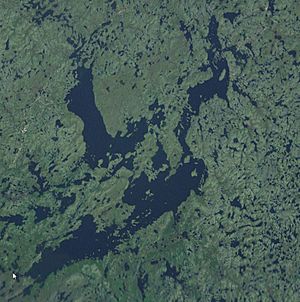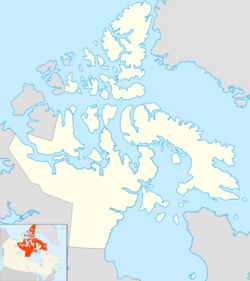Ennadai Lake facts for kids
Quick facts for kids Ennadai Lake |
|
|---|---|

Ennadai Lake
|
|
| Location | Kivalliq Region, Nunavut |
| Coordinates | 60°55′N 101°20′W / 60.917°N 101.333°W |
| Primary outflows | Kazan River |
| Basin countries | Canada |
| Max. length | 84 km (52 mi) |
| Max. width | 23 km (14 mi) |
| Surface area | 681 km2 (263 sq mi) |
| Surface elevation | 311 m (1,020 ft) |
Ennadai Lake is a large lake located in the Kivalliq Region of Nunavut, Canada. It stretches about 84 km (52 mi) long and 23 km (14 mi) wide. The lake is an important part of the northern landscape.
Water flows out of Ennadai Lake to the north, forming the start of the Kazan River. A long section of the Kazan River, about 615 km from Ennadai Lake to Baker Lake, was named a Canadian Heritage River in 1990. This means it's a special river that helps tell Canada's story.
Contents
Geography of Ennadai Lake
Ennadai Lake is found within a very old part of the Earth's crust called the Hearne Domain. This area has been shaped by glaciers and natural forces over millions of years.
Plants and Trees
Around the Kazan River's exit from Ennadai Lake, you can find some trees. These include thin black spruce and tamarack trees. They usually grow only about 1–2 m (3 ft 3 in – 6 ft 7 in) tall. This is because the area has strong winds and dry summers, which make it hard for trees to grow big.
Amazing Animals: Caribou Herds
Ennadai Lake is a key spot for the yearly journey of huge caribou herds. It's part of the migration route for the Qamanirjuaq herd, which has almost 500,000 caribou! Sometimes, the Beverly herd, with 275,000 members, also passes through.
The Beverly herd usually has its babies near Beverly Lake. The Qamanirjuaq herd gives birth near Qamanirjuaq Lake. Historically, both herds would travel south into Saskatchewan, Manitoba, and the Northwest Territories.
Since the 1960s, the Qamanirjuaq caribou have been changing their winter homes. They now gather near Cullaton Lake, Seal Hole Lake, and Ennadai Lake before their big spring migration. In late March or early April, tens of thousands of caribou fill these areas. They then travel east towards Hudson Bay and north to their calving grounds. Young caribou and mothers start their journey in April, and the male caribou follow in May.
History of the People
Until 1957, Ennadai Lake was home to the Ihalmiut people. These Caribou Inuit were also known as the "People from Beyond" or "Out-of-the-Way Dwellers." The Ihalmiut lived almost entirely by hunting caribou all year round. This was different from other Inuit groups who also hunted sea animals.
The ancestors of today's Inuit and Dene people used the Kazan River for over 5,000 years during the summer. They would move to the treeline or the coast for the rest of the year.
The ancestors of the Ahiarmiut moved inland from coastal areas in what is now Nunavut. When the Dene people started trading furs and stopped following caribou onto the tundra, the Ahiarmiut moved further inland. By about 1850, they reached the treeline. They spent spring and summer inland, catching caribou traveling north and camping on the caribou's calving grounds.
These inland Inuit also lived along the Kazan River, Little Dubawnt Lake (now called Kamilikuak), and north of the Thlewiaza River.
The Ihalmiut were skilled hunters. However, they faced times of hunger when caribou stayed in the southern forests instead of on the tundra. This also happened if they couldn't store enough food in the fall.
In the early 1890s, the Caribou Inuit began trading with European Canadians. They set up trap lines for white fox along their caribou hunting paths. They still relied on the Qamanirjuaq caribou for survival. But after difficult times in the late 1940s and 1950s, many people started moving into communities. The government encouraged this so children could go to school and families could get medical care.
On March 17, 2000, two pilots died in a plane crash while landing a Douglas DC-3 at Ennadai Lake. The plane was carrying building materials for a lodge.
Relocations of the Ihalmiut
The Government of Canada moved the Ihalmiut people from Ennadai Lake several times.
- In 1949, some Ihalmiut were moved to Nueltin Lake. But hunting was poor there, so they returned to Ennadai Lake. The Canadian Army built a radio station at Ennadai Lake that same year.
- In May 1957, Ihalmiut were flown from Ennadai Lake to Henik Lake. This area was about 45 miles from the Padlei trading post. However, caribou were scarce at Henik Lake, and many Ihalmiut faced starvation.
- Later in 1957, the Ihalmiut were moved again, this time to Whale Cove. Some people there began carving small figures to earn money.
- In 1958, 29 Ihalmiut went to Padlei for its trading post. 39 were at Yathkyed Lake, and most others were taken to Eskimo Point by the Royal Canadian Mounted Police.
- In 1959, the Padlei trading post closed. The remaining Ihalmiut were moved again.
The moves to Nueltin Lake and Henik Lake were not successful. The Ahiarmiut people themselves believed Ennadai Lake was an excellent hunting area. They did not understand why they were moved.
On September 7, 1985, 36 elders returned to Ennadai Lake. They had been moved from there in the 1950s.
David Serkoak, who was a child during the relocation, later tried to understand why the Ahiarmiut were moved. He wrote in 1985:
"[S]tarvation was approaching us, although some of the people at Ennadai lake were living quite well. Hard times came once in a while, but nothing very drastic. I don't believe that many people had much advance warning that they would have to move. Some of them found out the same day they were to be moved. When we returned to Ennadai recently, we stopped at a traditional camping spot where, the elders told us, a vehicle came to pick us up one day-we were told we had to move. The people had to pack so quickly that many articles were left behind. We were moved to the Henik lake area. That was when the real trouble hit us. I guess it was new for some of the people. The hardest time for them was between Ennadai lake and the coast. I think the idea behind the move had something to do with a change in caribou migration patterns, which meant that the caribou were farther away from the Ennadai lake area. I think the government wanted the Ihalmiut to move to the coast so that we might become fishermen and make ourselves useful."
—Serkoak, 1985
Workshops were held in 2003 and 2006 with Ahiarmiut elders. They talked about their lives and the events that changed them almost fifty years earlier. A weather station was also located in the area at Ennadai.
Government Apology and Settlement
In 2013, the Ennadai Lake Society asked the federal government for an official apology. They wanted an apology for the great difficulties the Ahiarmiut suffered during the repeated relocations from Ennadai Lake.
In 2018, the federal government reached an agreement with the survivors of these forced moves. They agreed to a $5 million settlement. In January 2019, the government announced that Minister Carolyn Bennett would deliver a formal apology on behalf of Canada. This apology took place in Arviat, Nunavut, on January 22.


